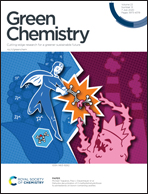Addressing the challenge of fabricating a high content regenerated cellulose/nanomaterial composite: the magical effect of urea †
Abstract
The solution processing of macromolecular cellulose material with a high content of incompatible nanomaterial is essential for its functionalization; however, this is still very tricky. Herein, urea is, for the first time, found to enable a simultaneous high filler concentration (56 mg ml−1), long-term stabilization, and the uniform dispersion of universal nanomaterials (i.e., pristine boron nitride nanosheets, graphene nanoplates, and carbon nanotubes) in an aqueous solution of cellulose, based on the tactful utilization of urea's non-covalent chemistry. Its N atom lone pair electrons and O atom empty orbital provide strong non-covalent interactions with nanomaterials, just like a dispersant; at the same time, it also serves as a protective additive for the low-temperature dissolution of cellulose into worm-like nanofibers, offering a volume exclusion effect. More interestingly, this small molecule could be totally removed during the regeneration process of cellulose, without any sacrifice of the composite's characteristics. These miscellaneous functions open up the gate for the green production of high-performance, multifunctional, and high-content regenerated cellulose/nanomaterial composites.



 Please wait while we load your content...
Please wait while we load your content...